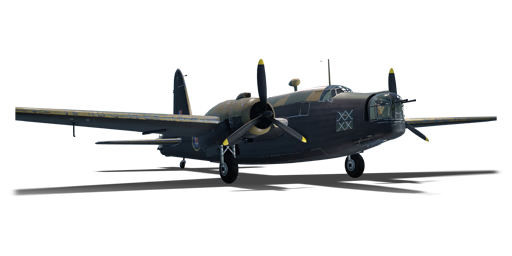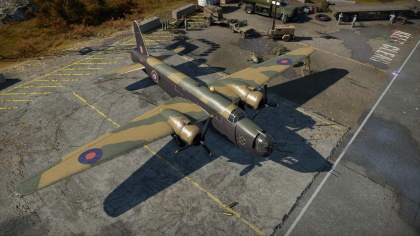Difference between revisions of "Wellington Mk III"
(→Flight Performance: Updated table design) |
CobraKingII (talk | contribs) (→Flight Performance) |
||
| Line 14: | Line 14: | ||
== General info == | == General info == | ||
=== Flight Performance === | === Flight Performance === | ||
| − | ''Describe how the aircraft behaves in the air. Speed, manoeuvrability, acceleration and allowable loads - these are the most important characteristics of the vehicle.'' | + | <!-- ''Describe how the aircraft behaves in the air. Speed, manoeuvrability, acceleration and allowable loads - these are the most important characteristics of the vehicle.'' --> |
{| class="wikitable" style="text-align:center" width="70%" | {| class="wikitable" style="text-align:center" width="70%" | ||
Revision as of 14:04, 15 August 2020
Contents
| This page is about the British bomber Wellington Mk III. For other uses, see Wellington (Family). |
Description
The Wellington Mk III is a rank II British bomber
with a battle rating of 3.0 (AB/RB) and 4.0 (SB). This aircraft has been in the game since the start of the Open Beta Test prior to Update 1.27.
General info
Flight Performance
| Characteristics | Max Speed (km/h at 4,572 m) |
Max altitude (metres) |
Turn time (seconds) |
Rate of climb (metres/second) |
Take-off run (metres) | |||
|---|---|---|---|---|---|---|---|---|
| AB | RB | AB | RB | AB | RB | |||
| Stock | 398 | 384 | 7000 | 31.3 | 32.5 | 3.1 | 3.1 | 650 |
| Upgraded | 441 | 418 | 28.4 | 30.0 | 10.2 | 5.3 | ||
Details
| Features | ||||
|---|---|---|---|---|
| Combat flaps | Take-off flaps | Landing flaps | Air brakes | Arrestor gear |
| ✓ | ✓ | ✓ | X | X |
| Limits | ||||||
|---|---|---|---|---|---|---|
| Wings (km/h) | Gear (km/h) | Flaps (km/h) | Max Static G | |||
| Combat | Take-off | Landing | + | - | ||
| 530 | 264 | 355 | 264 | 223 | ~5 | ~3 |
| Optimal velocities (km/h) | |||
|---|---|---|---|
| Ailerons | Rudder | Elevators | Radiator |
| < 275 | < 275 | < 310 | > 320 |
| Compressor (RB/SB) | ||
|---|---|---|
| Setting 1 | ||
| Optimal altitude | 100% Engine power | WEP Engine power |
| 310 m | 1,325 hp | 1,621 hp |
| Setting 2 | ||
| Optimal altitude | 100% Engine power | WEP Engine power |
| 3,810 m | 1,200 hp | 1,468 hp |
Survivability and armour
- 9 mm Steel plate in the pilot's seat.
Armaments
Suspended armament
The Wellington Mk III can be outfitted with the following ordnance:
- 10 x 250 lb G.P. 250 lb Mk.IV bombs (2,500 lb total)
- 18 x 250 lb G.P. 250 lb Mk.IV bombs (4,500 lb total)
- 9 x 500 lb G.P. 500 lb Mk.IV bombs (4,500 lb total)
- 2 x 1,000 lb AN-M65A1 bombs + 6 x 250 lb G.P. 250 lb Mk.IV bombs (3,500 lb total)
- 2 x 18 inch Mark XII torpedoes
- 1 x 4,000 lb H.C. 4,000 lb Mk.II bomb (4,000 lb total)
Defensive armament
The Wellington Mk III is defended by:
- 2 x 7.7 mm Browning .303 machine guns, nose turret (1,200 rpg = 2,400 total)
- 4 x 7.7 mm Browning .303 machine guns, rear turret (2,000 rpg = 8,000 total)
- 1 x 7.7 mm Browning .303 machine gun, 2 x side turrets (1,200 rpg)
Usage in battles
Describe the tactics of playing in an aircraft, the features of using vehicles in a team and advice on tactics. Refrain from creating a "guide" - do not impose a single point of view, but instead, give the reader food for thought. Examine the most dangerous enemies and give recommendations on fighting them. If necessary, note the specifics of the game in different modes (AB, RB, SB).
Manual Engine Control
| MEC elements | ||||||
|---|---|---|---|---|---|---|
| Mixer | Pitch | Radiator | Supercharger | Turbocharger | ||
| Oil | Water | Type | ||||
| Not controllable | Controllable Not auto controlled |
Controllable Not auto controlled |
Controllable Not auto controlled |
Separate | Controllable 2 gears |
Not controllable |
Modules
| Tier | Flight performance | Survivability | Weaponry | ||
|---|---|---|---|---|---|
| I | Fuselage repair | Radiator | Turret 7 mm | TC mk.I | |
| II | Compressor | Airframe | LBC mk.I | ||
| III | Wings repair | Engine | Protective vest | New 7 mm MGs (turret) | SBC mk.I |
| IV | Engine injection | Cover | MBC mk.I | ||
Pros and cons
Pros:
- Has twice as many tail guns as its predecessor
- Can carry a reasonable maximum payload for a medium bomber
- Engines seem to be indestructible and will remain operational even under heavy fire
- Can survive belly landings if need be
- Half-decent at operating in the gunship role
- Engines are capable of using WEP
Cons:
- Weaponry consists purely of 7.7 mm machine guns, making fighting against fighters a serious challenge at best
- Low speed makes the lack of defensive guns painfully obvious
- Anything with a cannon will be able to destroy the bomber without much effort
- Gun turrets have no protective armour, leaving turret gunners vulnerable
- Although you can carry torpedoes, they are some of the worst ones in the game due to the terrible drop requirements
- Tail controls are easily knocked out from fighters or flak
History
Describe the history of the creation and combat usage of the aircraft in more detail than in the introduction. If the historical reference turns out to be too big, take it to a separate article, taking a link to the article about the vehicle and adding a block "/ History" (example: https://wiki.warthunder.com/(Vehicle-name)/History) and add a link to it here using the main template. Be sure to reference text and sources by using <ref>, as well as adding them at the end of the article. This section may also include the vehicle's dev blog entry (if applicable) and the in-game encyclopedia description (under === Encyclopedia Info ===, also if applicable).
In-game description
The Vickers Wellington was a twin-engine medium bomber used by RAF Bomber Command and Coastal Command. In May 1939, a prototype Wellington was fitted with Bristol Hercules engines; after successful trials with a converted Mk.IC, this model was launched for full-scale production at the beginning of 1941 under the designation of Wellington Mk.III (Type 417).
Production Mk.III aircraft were equipped with two 1,590 hp Bristol Hercules Mk.XI radial, air-cooled engines.
Building on the experience amassed by Wellington crews, the defensive armament was upgraded on later models; the Frazer-Nash FN-5A rear turret with two 0.303 inch machine guns was replaced with a Frazer-Nash FN-20 turret holding four 0.303 inch machine guns with 2,000 rounds each. The take-off weight of the Mk.III was increased to 15,650 kg while bomb capacity was reduced to 4,000 lbs (1,814 kg). Originally, the bomber was to be equipped with a ventral turret, the low-drag Frazer-Nash FN-21A, but the further decrease in bomb capacity was deemed to be unacceptable.
The Mk.III had its armor reinforced, all fuel tanks were self-sealing and barrage balloon cable cutters were positioned in the leading edge of the wings.
By 1941 the Wellington was used almost exclusively at night and therefore, attention was given to decreasing the area of the glazing that visibly reflected moonlight or searchlight beams during night flights. To that end, the Mk.III differed from the late Mk.IC aircraft by removing side glazing and the side blisters of the bombardier/navigator's cockpit. The only side glazing that remained was from the trapezoidal gun blisters.
The Wellington Mk.III was manufactured until the end of 1943, and a combined total of 1,519 bombers were produced.
Media
See also
Links to the articles on the War Thunder Wiki that you think will be useful for the reader, for example:
- reference to the series of the aircraft;
- links to approximate analogues of other nations and research trees.
External links
Paste links to sources and external resources, such as:
- topic on the official game forum;
- encyclopedia page on the aircraft;
- other literature.
| Vickers-Armstrongs Aircraft Limited | |
|---|---|
| Bombers | Wellington Mk Ic · Wellington Mk Ic/L · Wellington Mk III · Wellington Mk X |
| Captured | ▀Wellington Mk Ic |
| Britain bombers | |
|---|---|
| Torpedo | Swordfish Mk I · Swordfish Mk II · ▄Avenger Mk II |
| Dive | V-156-B1 |
| Hydroplanes | ▄Catalina Mk IIIa · Sunderland Mk IIIa · Sunderland Mk V |
| Light | Blenheim Mk IV · Beaufort Mk VIII · ▄Hudson Mk V · Brigand B 1 |
| Based on A20 | ▄Havoc Mk I · ▄Boston Mk I · ▄DB-7 |
| Hampden | Hampden Mk I · Hampden TB Mk I |
| Wellington | Wellington Mk Ic · Wellington Mk Ic/L · Wellington Mk III · Wellington Mk X |
| Halifax | Halifax B Mk IIIa |
| Stirling | Stirling B Mk I · Stirling B Mk III |
| Lancaster | Lancaster B Mk I · Lancaster B Mk III |
| Lincoln | Lincoln B Mk II |
| Shackleton | Shackleton MR.Mk.2 |





